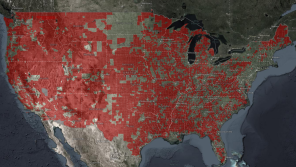Federal data shows divide in internet adoption between rural, urban areas persists

People living in rural communities still lag behind residents of urban areas when it comes to internet adoption, according to a new analysis by the National Telecommunications and Information Administration.
The federal researchers released the results of their examination of 2015 Census data Wednesday, noting that while 75 percent of urban residents reported using the internet last year, only 69 percent of rural residents did so.
In a blog post, NTIA Policy Analyst Edward Carlson and Justin Goss — an intern in the agency’s Office of Policy Analysis and Development — write that internet use has “increased dramatically overall” nationwide, but this “digital divide” persists between urban and rural communities.
“This data indicates a fairly constant 6 to 9 percentage point gap between rural and urban communities’ internet use over time,” the analysts wrote.
The researchers also noted that this disparity exists in rural areas, “regardless of race or ethnicity.” Nationally, 78 percent of whites reported using the internet, compared to 68 percent of African Americans and 66 percent of Hispanics. In rural areas, those numbers drop to 70 percent, 59 percent and 61 percent respectively.
The analysts also compared annual family income levels against internet adoption rates, and again, they noticed a gap between urban and rural residents.
“The biggest gap in internet use between rural and urban Americans based on income came among those with incomes between $25,000 and $49,999,” the analysts wrote. “66 percent of rural residents in that income range used the internet, compared with 70 percent of their urban counterparts.”
[Read more: Kentucky gov. scales back state-owned broadband network, prompting outcry]
People with lower levels of education were also “more likely to find themselves on the wrong side of the digital divide” when living in rural areas, according to the researchers.
Indeed, they found that 52 percent of people without high school diplomas in rural communities used the internet last year, compared to 59 percent of those in urban areas. For high school graduates, the gap was smaller, but still existed: Sixty-nine percent of urban residents used the internet, compared to 63 percent of those in rural areas.
The researchers also examined how people used the internet across the country, finding that “living in a rural area was also associated with lower levels of device use, internet use at particular locations and participation in online activities.”
Compared to people in urban areas, the researchers found that rural residents were less likely to use desktops, laptops, tablets and internet-enabled mobile phones. They also note that people in rural areas were more likely to not own any device capable of accessing the internet.
All these numbers directly correspond with other federal surveys of nationwide internet access. In a January report, the Federal Communications Commission found that just 4 percent urban residents lack broadband access, but 39 percent of rural residents can’t obtain high-speed service.






